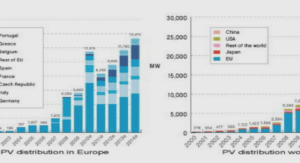The sun is a complex radiator with a spectrum that can be approximated by the spectrum of a 5525K (5250°C) black body. This spectrum is then modified and affected by many variation factors such as temperature across the sun’s disk, Fraunhofer absorption lines, and the path length through the earth’s atmosphere. It was reported that, up to about 70% of energy within the light arriving is absorbed by clouds, oceans and land masses. Figure 2.1 shows the solar radiation spectrum for direct light at both the top of the Earth’s atmosphere and at sea level, as a function of wavelength, where the red part is the energy absorbed on sea level.When the sun is shining near its peak, with a relative modest 10% overall efficiency, 1kW of electricity would be generated for every 10m2 of active area, which is equal to the average electricity per residence. However, as the sun doesn’t shine at its peak intensity for whole day, electrical storage devices are required for all solar cell devices.
Titanium dioxide and its derivatives for alternative energy
Titanium Dioxide Nanoparticles
Titanium dioxide (TiO2), which is also called as titania or titanium (IV), was first discovered in 1891, and was commercialized in 1961 as white pigment. Still then, it remains as one of the most promising and interesting materials due to its high photostability, high oxidation efficiency, non-toxicity, chemical inertness, biocompatibility, environmentally friendly nature, and low cost production. Since 1972, the phenomenon of photocatalytic splitting of water on TiO2 electrode by Fujishima and Honda was firstly reported, then an exponential growth of research activities on TiO2 and its derivatives have been seen in various applications, such as photovoltaics, photocatalysis, batteries, sensors, ultraviolet blockers, pigments, surface coating, and paints.1–10 TiO2 belongs to the family of transition metal oxides. In nature, TiO2 has four polymorphs: rutile (tetragonal), anatase (tetragonal), brookite (orthorhombic) and TiO2 (B) (monoclinic).11 In addition, four more structures were synthesized under high pressure, which are TiO2 (II) with a PbO2 structure, TiO2 (H) with a hollandite structure, baddelleyite and cotunnite.12–15 Among them, the two polymorphs anatase and rutile are mostly manufactured in chemical industry as crystalline materials. In fundamental studies, the anatase and rutile TiO2 structures both have tetragonal structure but the distortion of interconnected TiO6 octahedron is slightly larger for anatase phase.16 In addition, each octahedron of TiO2 anatase is connected to 10 surrounding octahedrons, while those of TiO2 rutile are connected to 8 surrounding octahedrons.2 These differences in lattice structures are responsible for the mass densities and different electronic band gap energy structures between these two forms of TiO2. The band gap energy of TiO2 anatase phase is reported to be 3.2 eV, while the band gap energy of TiO2 rutile phase is 3.0 eV. This relatively wide band gap means that both TiO2 forms could be stimulated only under UV irradiation, and have low conversion efficiency under visible light.
Coupled Colloidal Structures
Since TiO2 NPs can only be excited by high energy UV irradiation with a wavelength shorter than 387 nm due to its relatively high energy band gap (3.2 eV), many investigations confirmed that the coupled colloidal structures, in which TiO2 NPs is coupled with different semiconductor particles, would extend the light absorption range of TiO2 from UV to visible light. This leads to an increase in charge separation, hence they result in higher activities in both photovoltaic and photocatalyst applications. Several coupled colloidal structures of TiO2, such as CdS/TiO2, ZnO/TiO2, Fe2O3/TiO2, SiO2/TiO2, SnO2/TiO2, Bi2S3/TiO2, WO3/TiO2, and MoO3/TiO2 have been reported.24–32 Among them, the coupled structure of CdS quantum dot and TiO2 NPs has received the most attention. CdS is a visible-light-driven photo-absorption with a narrow band gap of 2.4 eV. It has an absorption band between 450 – 470 nm for CdS nanoparticles, and at about 515 nm for the bulk crystalline CdS. Hence, CdS becomes an attractive candidate for photoabsorption under solar light. However, CdS is subjected to photoanodic corrosion in aqueous environment and has low quantum efficiency.33,34 To overcome this stability problem and improve the photovoltaic and photocatalytic activity, CdS has been combined with a wide band gap semiconductor, such as ZnO or TiO2, and this coupling gives reduced photogenerated electron-hole recombination.





